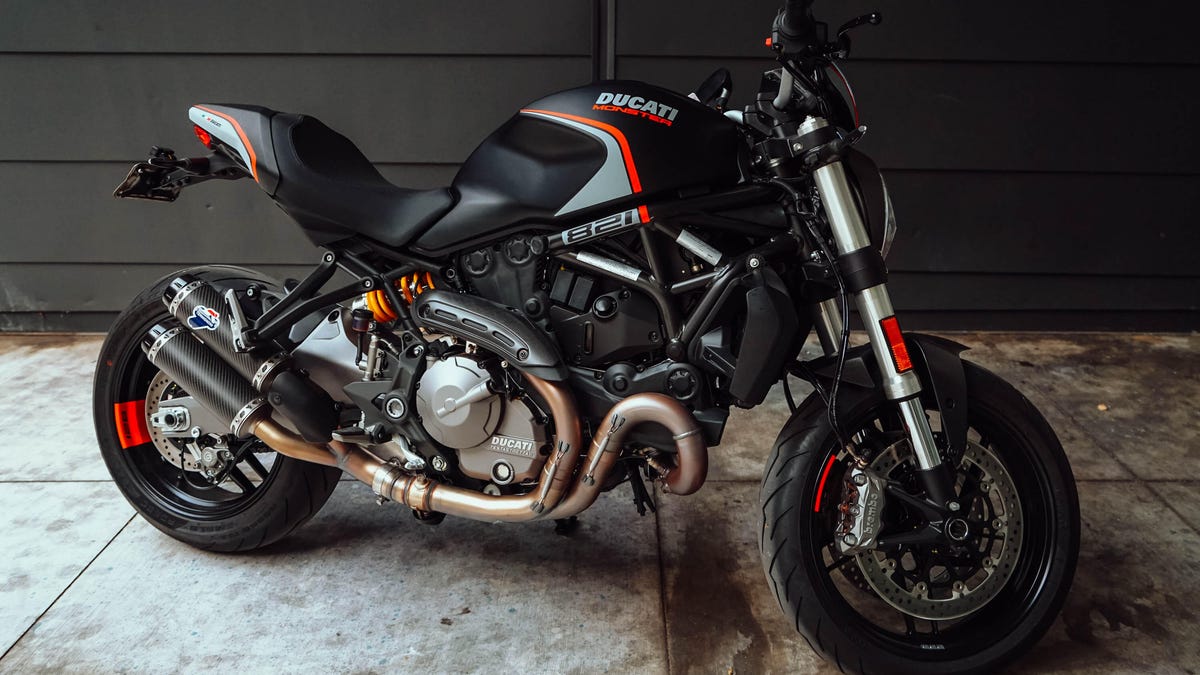2020 Ducati Monster 821 review: Stealth in name only
The middle Monster might not be everybody's daydream Ducati, but maybe it should be.

They called it a Monster, but there's nothing monstrous about it.
The Ducati Monster made its debut in 1993 and quickly became not only a design icon, but the standard by which all future naked bikes would be judged. In the intervening years, the Monster has evolved, but the original spirit is mostly there and it's arguably best experienced in the middle-child 821.
The Ducati Monster 821, shown here in Stealth trim, is powered by an 821-cc, water-cooled, L-twin engine that produces a robust-for-its-class 109 horsepower and 63 pound-feet of torque. Like other modern Ducatis, this engine offers an ideal blend of engaging-yet-friendly power delivery, unbelievably rowdy sound and lengthy service intervals (9,000 miles, to be exact).
Those first and last points are wildly different from early Monsters, which required regular, expensive service and had throttles that were best left to experienced riders due to the large carbureted engines' willingness to overcome traction. Coupled with no rider aids, that meant potential trouble for the inexperienced.
Not a bad-looking cockpit and it even has a night mode.
Now, the bike maker offers its Safety Pack on almost all of its bikes, which includes lean-sensitive antilock brakes, traction control and rider modes, all of which go a long way towards making the Ducati experience accessible to riders of almost any skill level. Very experienced riders can even turn most of the systems off or just dial them back -- something that's easily done thanks to the sophisticated nature of not only the systems themselves, but how they're controlled through the Ducati's full-color TFT display.
Things in the chassis department have a lot more in common with the original Monster, despite a nearly three-decade gap between them. The Monster 821 still has a gorgeous steel trellis frame that uses the engine as a stressed member of the chassis. It also uses high-quality dual front Brembo brake calipers that grab 320-millimeter rotors. This is a tried-and-true system used on many Ducati products and it offers tons of stopping power with a great deal of fine control and easy modulation for the rider. The suspension for the 821 Stealth consists of fully adjustable, 43-mm, upside-down forks, while the standard 821 gets nonadjustable forks. Both bikes have an adjustable monoshock out back.
My test bike has the optional carbon fiber Termignoni racing pipes, which are technically not road-legal and they sound absolutely heroic -- even if they set off car alarms and annoy people all over town. I'm a sucker for the sound of Ducati twins in general, but these pipes put the 821 Stealth on a whole other level. Is this exhaust worth the $1,650 asking price? Probably not, but after hearing it in person, I suspect plenty of people will throw good sense to the wind and get it anyway.
The riding experience of the 821 Stealth is borderline magical. It's a bike that can tick multiple -- often contradictory -- boxes at once. It's quick off the line, but it's also extremely easy to launch. It's nimble and willing to lean over without much effort yet it feels stable and confidence-inspiring on a freeway. It's sporty and aggressive but shockingly comfortable, even for long rides. It's loud and brash and Italian and frivolous, but also undemanding and not intimidating when you're just taking it easy.
This excellence isn't cheap. The 821 Stealth lacks the 1200's eye-watering price tag, but it's still $12,895 before you add any accessories. With all its carbon fiber trim, Rizoma milled aluminum goodies and that god-tier Termignoni exhaust, my test bike costs just under $17,000, which is close to the asking price for the much more powerful Monster 1200S.
The Panigale lineup might be Ducati's flagship, but the Monster is where the brand's heart lives. It's a bike that's seen careful evolution since its initial debut and riding it feels like a love letter to street bikes from the engineers who built it. The Monster 821 could be my only bike and I'd rarely find myself needing or wanting anything more.

